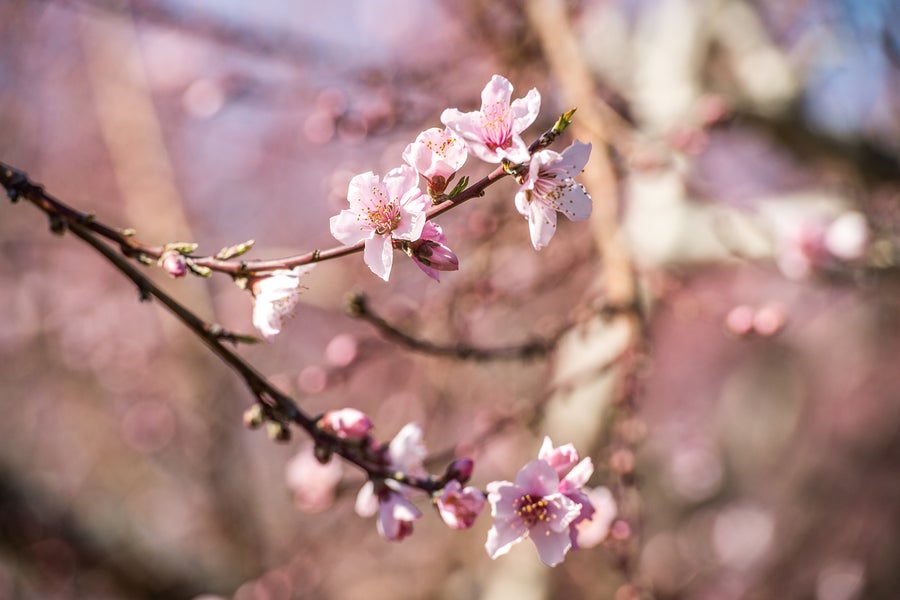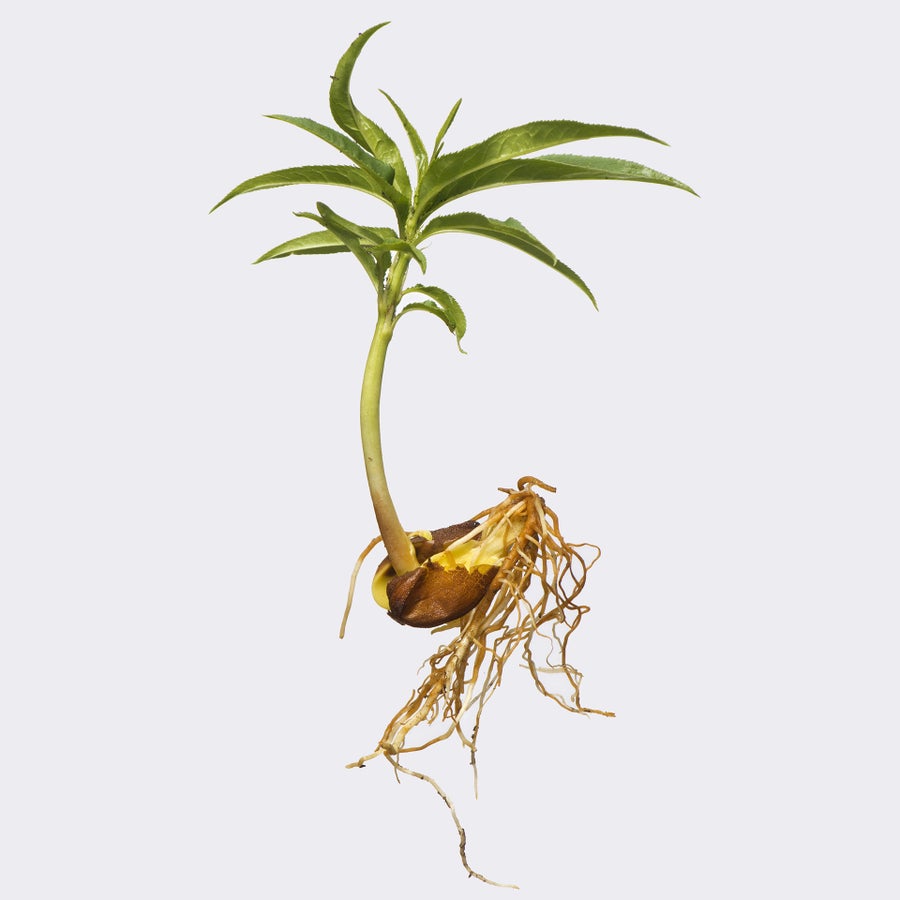Behind every peach you bite into is the work of countless human generations.
The fuzzy, sweet stone fruit traces back to China, where it has been cultivated for more than 8,000 years. It wasn’t until the 1500s that Spanish colonists carried peaches into the Americas when they first explored the North American Southeast, where the fruit gained a foothold in what is now Georgia. Scientists have known that much about this symbol of summer. But how did peaches become so widespread in the U.S.? Research published in September in Nature Communications argues that after the fruit was introduced by Europeans, the peach spread across much of what is now the eastern U.S. with the help of Indigenous peoples.
“Today, Georgia is the Peach State,” says botanist RaeLynn Butler, secretary of culture and humanities at the Muscogee (Creek) Nation and a co-author of the new research. “That legacy stems from a long history.” Much of that history comes from the Muscogee (Creek) Nation and other Indigenous communities that lived in the area when peaches first arrived in the Americas.
“A lot of choices and agency by Indigenous people played a huge role,” says Jacob Holland-Lulewicz, an archaeologist at Pennsylvania State University and a co-author of the new research. They “were also responsible for structuring the ecology and the landscape to be an appropriate place for peaches to grow, and they tended to the peach plants.”
Holland-Lulewicz had long noted reports of peach pits found at archaeological sites across the southeastern U.S. And a few years ago he decided to compile these into a more detailed picture of how peaches spread—one that could shed light on the Indigenous histories that archaeology has typically ignored or suppressed. “I started to think about [the fruit] as a trade good,” he says. “Maybe we could use peaches to track, at a really high resolution, how Indigenous communities were interacting.”
The research team gathered evidence from more than two dozen archaeological sites and several early towns across the southeastern U.S. where one or more peaches had been discovered. Previous research at some of these sites had already provided a time frame for the presence of peaches. For the sites where that age had not yet been determined, the researchers used radiocarbon dating, either directly on peach pits or on other nearby materials to establish when peaches were likely present.

VW Pics/Universal Images Group via Getty Images
This work, however, showed only where peach pits had survived—not how people used the fruit or seeds. “We can’t see what people actually did with peaches and peach pits, so we’re making inferences based on the archaeological record,” says Kristen Gremillion, an archaeobotanist at the Ohio State University, who has researched peach history in the Americas but was not involved in the new research.
Perhaps the most surprising date the study authors determined comes from a site in inland Georgia, where Ancestral Muskogean people lived for a few decades beginning in the early to mid-1500s. The researchers suggest that the two peach pits found at this site may be related to Hernando de Soto’s early expedition inland in 1540, one of a series of journeys that bands of Spaniards made during their first century in the Americas.
Beyond this outlier, the peach pits didn’t appear to reach inland Georgia until decades later. The bulk of early peaches, dating to before 1600, come from coastal Florida and Georgia. The fruit then spread across a swath of northern Florida and southern Georgia between 1625 and 1640. By 1650, peaches had moved throughout the rest of Georgia and eastern Alabama, plus some sites in North Carolina and eastern Tennessee. The fruit had reached Arkansas by the 1670s, the researchers found, and prior archaeological records show peaches arriving in New York State before the beginning of the 18th century.
The pattern struck Holland-Lulewicz and his co-authors as both surprising and telling. The Spanish pivoted from occasional expeditions to putting down roots in the Southeast beginning in the 1560s, and only then did peaches appear to do the same. But throughout the time of the great peach migration, most Europeans in North America were still concentrated in small population centers along the coasts. The fruit’s spread vastly outpaced Spanish colonization, suggesting that Indigenous people, not Spanish explorers and conquistadors, did the work.
“This spread really started when Indigenous networks and Spanish networks were starting to be entangled with one another,” Holland-Lulewicz says. “From there, peaches are being spread through the rest of the Indigenous networks to communities and towns that may have never even, still, met a Spanish person.”
Given how quickly peach pits spread and how long it takes peach trees to bear fruit, he says, Indigenous peoples must have transferred them along existing networks. “This land was a continent of active sociopolitical entities and communities and nations,” Holland-Lulewicz says. “These relationships created this entire continental web of interaction. These were not disconnected people living in the forest.”
On supporting science journalism
If you’re enjoying this article, consider supporting our award-winning journalism by subscribing. By purchasing a subscription you are helping to ensure the future of impactful stories about the discoveries and ideas shaping our world today.

Roots and leaves of a seedling peach tree.
imageBROKER.com GmbH & Co. KG/Nigel Cattlin/Alamy Stock Photo
From Butler’s experience as both a botanist and a member of the Muscogee (Creek) nation, the findings are no surprise. Her ancestors lived across what is now Alabama, Georgia, Florida and South Carolina until the 1830s, when the U.S. Army brutally forced Indigenous nations of the Southeast westward to Oklahoma in what is often referred to as the Trail of Tears.
The Muscogee (Creek) Nation’s connection with peaches survived the trauma, a testament to the importance of the crop to its members’ lives in the U.S. East. For example, the nation included the ripening of peaches among the timekeeping milestones it saw in the natural world, Butler says. Her hereditary tribal town, Pakan Tallahassee, was named for peaches, and she says these ancestors would have shared the fruit with other communities and taken care of the trees—no small feat, she notes. “You’ve got to be determined and patient,” Butler says.
Indigenous peoples would have been well-equipped to cultivate peaches from experience with other tree crops such as pawpaws and chestnuts, Holland-Lulewicz says. And Indigenous practices such as controlled burns would have created open landscapes that favored sun-loving plants such as peaches.
The U.S. Indian Removal Act of the 1830s uprooted Indigenous nations, including Butler’s ancestors, who carried peach pits on the long journey west and still tend trees in Oklahoma. Back in the East, peach trees suddenly left untended sometimes became too overgrown to bear much fruit. Others survived on farmsteads, where their fruit was fed to pigs or turned into cider, says William Thomas Okie, a historian at Kennesaw State University, who has written about peaches but was not involved in the new research.
Despite the historical importance of peaches across the eastern U.S., the modern peach industry that began in the late 1800s is linked to a separate introduction of a specific large, attractive variety from Asia called the Chinese Cling, Okie says. But some of the commercialized cultivars may have mixed the Chinese Cling and other later arrivals with the peach varieties grown by Indigenous breeders across the southeastern U.S. before their eviction, he says.
Butler hopes future research will examine different peach varieties—particularly those her nation continues to grow in Oklahoma—and determine whether they are genetically related to the first fruits Indigenous groups spread across the eastern U.S. “It’s just neat to see science in action and how it applies to everyday life,” she says. “Everyone has enjoyed a peach at some point in their life but maybe never thought about how it got here.”
